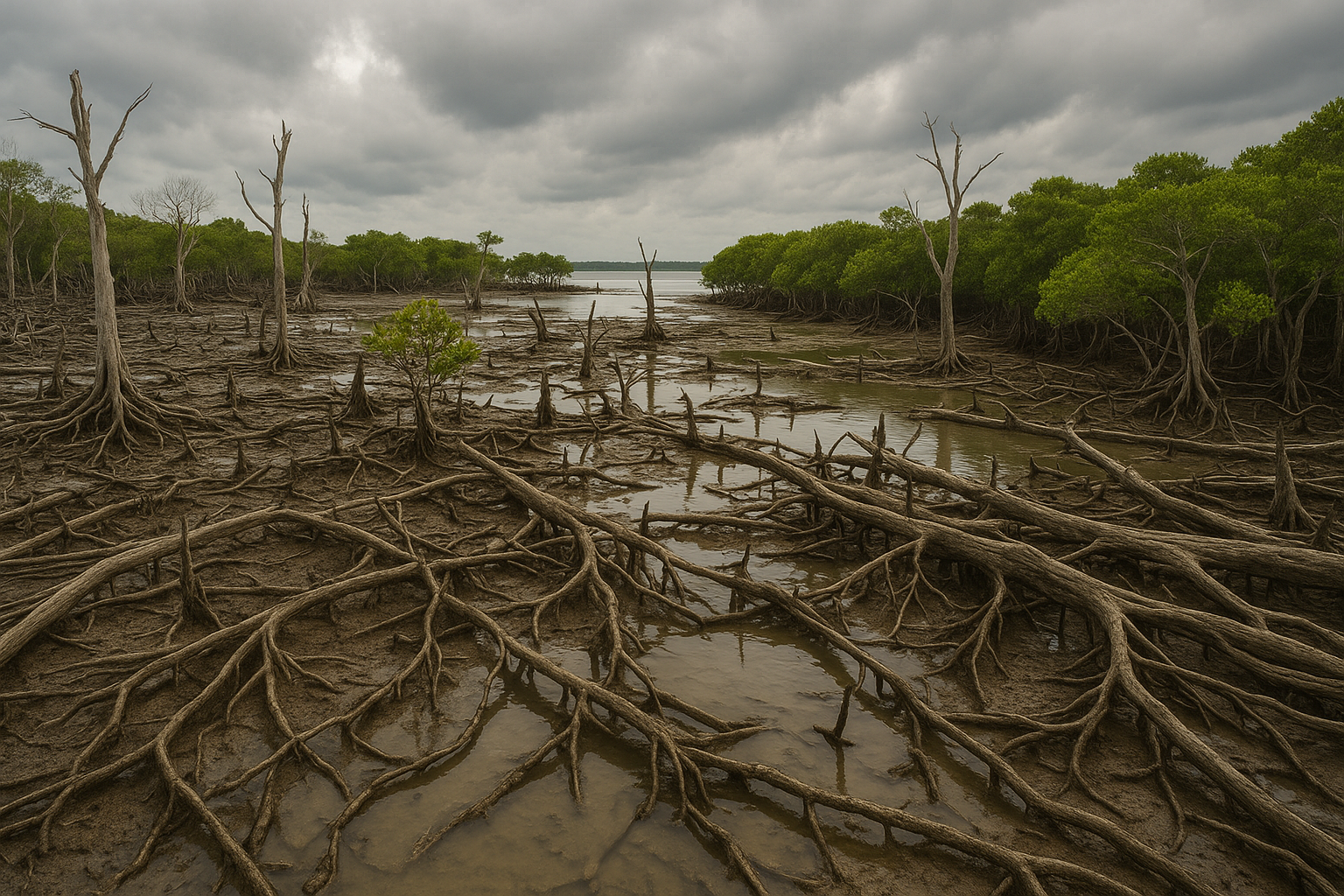Decline in Mangrove Carbon Stocks Threatens Climate Goals, Says World Bank Report
The World Bank’s Changing Wealth of Nations highlights mangroves as vital natural assets, storing over 8.5 gigatons of carbon while protecting coastlines and livelihoods. Despite their immense value, global mangrove carbon stocks fell 4% between 1996 and 2020, underscoring urgent needs for conservation and restoration.

The World Bank’s report, Changing Wealth of Nations, turns the spotlight on mangroves, those swampy coastal forests long overlooked in policy debates yet central to both human survival and climate stability. These ecosystems, though occupying a small fraction of global land, punch far above their weight: they feed millions, protect coastlines from billion-dollar storms, and lock away vast reserves of carbon. By quantifying mangrove carbon stocks at a global scale, the report reframes them as not just ecological treasures but as renewable natural capital, assets that underpin economic prosperity and resilience in an era of mounting climate stress.
A Wealth of Carbon Beneath the Roots
Mangroves are among the world’s most carbon-rich ecosystems. They hold carbon in three distinct “pools”: living biomass above and below ground, non-living organic matter such as leaf litter and dead wood, and soils that trap carbon under waterlogged, oxygen-poor conditions. These soils are the true giants, storing almost 80 percent of total mangrove carbon, some of it centuries old.
Globally, mangroves shelter 4.1 million small-scale fishers and provide storm protection worth an estimated $65 billion annually. Yet, since 1980, up to 35 percent of mangrove ecosystems have been lost, cleared for agriculture, squeezed by urban sprawl, or eroded by rising seas. The report underscores a stark warning: if degradation continues, mangroves could shift from carbon sinks to carbon sources, amplifying climate risks rather than reducing them.
Crunching the Numbers: A Global Dataset
For the first time, the World Bank has compiled a comprehensive dataset to assess mangrove carbon storage across 122 countries, covering six benchmark years: 1996, 2007, 2010, 2015, 2018, and 2020. Drawing on cutting-edge sources such as the Global Mangrove Watch, canopy height maps, and soil carbon models, the study estimates stocks within a consistent framework.
The headline figure is sobering: global mangrove carbon stocks fell from 7,303 million metric tonnes (MMT) in 1996 to 6,976 MMT in 2020, a 4 percent decline. Losses were sharpest between 1996 and 2010, when 285 MMT of carbon disappeared. Stabilization has occurred in the past decade, with minor increases in 2020 hinting at the impact of stronger conservation measures. Still, the overall decline reveals the vulnerability of these ecosystems, even as their importance to climate strategies grows.
Winners, Losers, and Uneven Fortunes
The story of mangrove carbon is highly uneven. Indonesia towers above all others, holding roughly a quarter of global stocks but also bearing some of the heaviest losses. Brazil, Nigeria, Australia, and Mexico rank next, though most show gradual declines over time. By contrast, countries like Bangladesh and French Guiana managed modest gains. Bangladesh, with more than 80 percent of its mangroves under protection, has seen carbon storage inch upward thanks to community-led restoration in the Sundarbans. In Venezuela, sediment from inland deforestation has ironically boosted coastal mangrove growth in the Amacuro Delta.
Regional patterns reinforce these contrasts. East Asia and the Pacific remain the largest carbon reservoirs, followed by Latin America and the Caribbean. Sub-Saharan Africa also holds significant stocks but has suffered consistent erosion, while the Middle East and North Africa contribute little globally. Income grouping tells another story: lower-middle-income economies, including Indonesia, account for half the world’s mangrove carbon. This fact underscores the disproportionate role of developing countries in stewarding blue carbon assets critical to the global fight against climate change.
What Drives Loss, and Where Hope Lies
Human activity has been the dominant driver of mangrove destruction. Between 2000 and 2016, 62 percent of global loss stemmed from anthropogenic causes, particularly the expansion of agriculture, aquaculture, and timber extraction. Southeast Asia was the hardest-hit, with Indonesia, Myanmar, Malaysia, and Vietnam at the forefront. Natural forces also played a role: shoreline erosion and extreme weather events accounted for nearly 40 percent of losses.
Yet there are glimmers of hope. Since 2007, rates of decline have slowed, with some countries recording net gains. Restoration projects, expanded legal protections, and rising awareness of mangroves’ economic and climate value are beginning to make a difference. Still, the report stresses that protection alone does not guarantee safety: even mangroves within designated conservation zones have been lost to illicit clearing or weak enforcement.
Policy Lessons and the Road Ahead
For policymakers, the implications are clear. Carbon stock estimates from this report can help countries integrate mangroves into their Nationally Determined Contributions (NDCs) under the Paris Agreement. They can guide investments in restoration, highlight hotspots for protection, and provide a foundation for blue carbon financing schemes. For lower- and middle-income countries, where the bulk of mangrove carbon resides, the data strengthen the case for international support and innovative financing.
The World Bank cautions that its numbers are not precise enough for national carbon markets or inventories, given methodological uncertainties. Still, they represent the most consistent global baseline available. The dataset is also designed to evolve: as new mapping and soil studies emerge, the framework allows for updates, ensuring that future editions of The Changing Wealth of Nations can provide sharper insights.
- FIRST PUBLISHED IN:
- Devdiscourse
ALSO READ
World Bank Report Charts $10 Trillion Pathway to Decarbonize East Asia’s Energy
World Bank Pushes Results-Based Climate Finance to Link Carbon Action with Growth
World Bank Approves $47.9M Education Grant to Boost Schooling in Punjab
World Bank–Egypt Partnership Framework Targets Inclusive Growth and Reform










